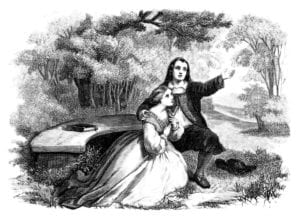The Playwright
There was no theatre troupe in Stratford when Shakespeare was growing up, and no theatre. But theatre troupes did periodically visit the town to perform, and it seems likely that Shakespeare made his way to London, maybe in his mid-twenties, in the company of a troupe of visiting players returning to the capital.
This can only be speculation because almost nothing certain is known about the steps he took to establish himself as a literary figure in London. Here is what we do know: born in 1564, he marries at 18 in late 1582, becomes a father for the first time in the spring of 1583 (a daughter, Susanna), fathers twins in 1585 (Hamnet and Judith) – and then reappears in London in 1592, seven years later, enough of a literary lion to be worth criticising (“an upstart Crow”) for plagiarism. The connections between the first part of that sentence and the last part have been irretrievably lost.
We can speculate. By the early 1590s, he is established as a successful playwright, having by this stage (probably) written at least two Comedies – “Two Gentlemen of Verona” and “The Taming of the Shrew” – along with three Histories, the three parts of “Henry VI”. In 1593 the theatres are locked down (to borrow a contemporary phrase) because of the plague, and Shakespeare takes a break from the theatre to write “Venus and Adonis”, a fluent, bawdy narrative poem that delighted a huge audience and made him the most popular poet in the kingdom. The following year the theatres are closed again, and Shakespeare turns his quill to darker matter: “The Rape of Lucrece” is a vivid and painful account of sexual violence and its aftermath. The two poems leave him financially independent and free to write what he wants. He returns to drama.
The Actors
Shakespeare belongs to a theatre troupe called the Lord Chamberlain’s Men. Each troupe of actors in London has their own playwright, and Shakespeare has by now (the early 1590s, approaching thirty) established himself in this role. He was probably still acting – there is a tradition that he played old men, though again no evidence survives one way or the other – but he provided the scripts for the Comedies (“The Comedy of Errors”, “Love’s Labour’s Lost”) and the Histories (“Henry IV parts one and two”, “Henry V” and so on) that filled his theatre and made him rich.
Which theatre? From 1594, Shakespeare’s troupe used The Theatre, built at Shoreditch in 1576 by James Burbage, whose younger son Richard was to become a companion and colleague of Shakespeare’s. When the theatres were closed in the summer of 1597 – censorship this time, not the plague – the Lord Chamberlain’s men were forced to move on, and between 1597 and 1598, they performed at The Curtain, also north of the river. The Theatre was dismantled beam by beam, transported across the Thames in January 1599, and rebuilt as The Globe following a design by Cuthbert Burbage (James’s older son), to serve as Shakespeare’s theatrical home until it burnt down in 1613 when its thatch caught fire. But by this stage, Shakespeare was semi-detached from the stage, and living largely in Stratford.
The Theatres
In 1603, the Lord Chamberlain’s Men changed their name and their patronage. The most successful thespians in the country were invited to become the King’s Men in deference to the new monarch, and in 1608, they acquired a second theatre, the Blackfriars (built originally in 1596), to reflect their status. This theatre had the great benefit of being enclosed – unlike the Globe – and could therefore use artificial light. Something close to a modern theatre may be imagined. Blackfriars was the company’s home of choice in the winter, leaving the Globe for the summer season.
How did a theatre troupe operate in Jacobean London? The Blackfriars was rented on a lease costing forty pounds per annum, shared between seven members of the company, including Shakespeare. Once any other liabilities had been covered, the rest was profit. A troupe with a writer as accomplished as Shakespeare would be likely to charge a high price for admission and the Blackfriars could seat 700 at a sitting (2,000 at The Globe). It is possible to see how large profits might be made.
The Bottom Line
The King’s Men were lucky in their playwright, but he was lucky in turn, because they were a stable troupe and because they were talented actors. A number of the actors became shareholders in the Globe – Will Kemp (the most popular comic actor in the country, though he later fell out with the company); Augustine Phillips; John Heminge (who a generation later was one of those responsible for publishing the First Folio of Shakespeare’s plays); Thomas Pope; James Burbage and his brother Richard. Together with Shakespeare these seven provided a stable atmosphere for the plays to be written, performed and turned to profit.
Shakespeare’s roles in this troupe were evidently quite various: share-holder, part-time actor, full-time author, and no doubt director and producer too, he may also have had a part to play in the finances, since he was clearly accomplished with money. This must have got complicated: play scripts belonged to theatre troupes, and the routine was that the playwright would sell the completed script for a set sum – perhaps £2. Copies of this script might be published – around two dozen of Shakespeare’s plays would be published in his life time – but not by him and not by his company: the last thing they wanted was for scripts to circulate among punters who might otherwise pay their penny at the gate. So these scripts (to use an anachronistic term) were bootlegs, pale imitations of the real thing.




